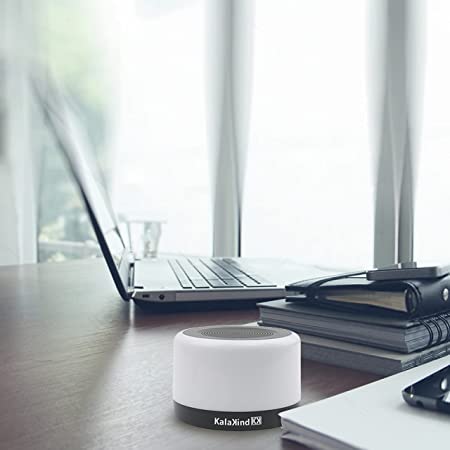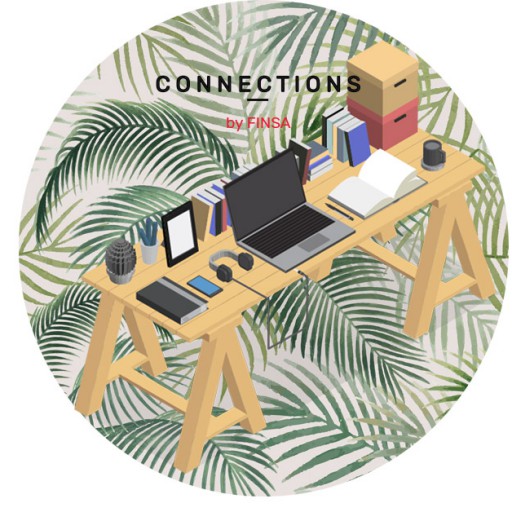Have you ever fallen asleep peacefully listening to the sound of the rain fall outside your window or the chirping of crickets in the countryside? White noise is homogenous and constant sound that prevents us from paying attention to any others because it contains all the frequencies that the human ear can hear.
It’s also known as broadband noise because it includes multiple audible bandwidths. Some examples include the sound of a TV or radio that has not been tuned, the sound of trains on a track, and waves breaking on the shore.

The concept is closely related to the Autonomous Sensory Meridian Response, or ASMR, but there are some differences. As we explained in our Connections By Finsa article entitled “What is ASMR and how does it influence us?”, ASMR is all about the sense relaxation that some people experience when they listen to certain repetitive sounds, such as someone turning the pages of a book or typing on a keyboard, whereas white noise cancels out and masks other sounds. Let’s take a look at some of the uses and benefits of the latter.
Erasing noise pollution
White noise, which is a constant sound, is designed to block out any other surrounding murmurs that might cause distress, with its main benefit being helping us to concentrate, relax, and rest.
This is why white noise is known for improving sleep onset for both babies and adults. But is it really all that useful? Can it even be detrimental? As Doctor María José Lavilla explained on Spanish television program Saber Vivir, “White noise can be a good option for people who live in the city and sleep very lightly, as well as for those who are used to sleeping with traffic noises in the background”.

Noise pollution has been identified by the World Health Organisation (WHO) as a public health issue and is one of the main problems in modern society. Interior design is placing more and more importance on building spaces that are acoustically comfortable with white noise being seen as one solution that can help mask background noise.
Where can I find white noise?
The first source of this type of noise is nature – the sound of rain falling or waves crashing – of which there are many recordings to be found in Youtube videos and Spotify playlists. You can also find dishwasher, washing machine, and TV sounds on several different podcasts.
Our article “The best white noise playlists” can help you discover some interest hours-long playlists, each of which has been designed with a different purpose in mind.
Technology has also surrendered to the white noise trend, with many small machines that emit soft, continuous sounds at the same frequency now on the market. Will they become the next must-have gadget for every home in the world?

The business of creating white noise
According to Bloomberg, some people who work as white noise creators receive monthly payments exceeding $18,000. Todd Moore, from the podcast “Tmsoft’s White Noise Sleep Sounds”, was interviewed for the publication’s article entitled “Spotify Podcasters Are Making $18,000 a Month With Nothing But White Noise”. Moore stated that his white noise episodes are being listened to approximately 50,000 times a day.
Medium was also intrigued by the business behind white noise tracks, publishing an article in OneZero about Ameritz, a company that collaborates with Peak Records to fill hundreds of artist profiles on Spotify with white noise. Editor Pedro Slattery estimates that their main profiles make about a million dollars a year.
Pink noise and brown noise
There’s more than just white noise out there on the internet: now there’s pink noise and brown noise, too.
Pink noise also contains all the audible frequencies, but with an emphasis on the lower ones. Some examples include leaves rustling, wind howling, or a heart beating. Whereas white noise helps you fall asleep, pink noise improves your memory.
Then there’s brown noise, which has gone viral on TikTok in the last few weeks. This type of noise is deeper and heavily features the lowest frequencies in the audio spectrum. A good example is the sound of thunder. Its main benefit lies in improving concentration. TikTok users can’t stop uploading videos of themselves reacting to hearing brown noise for the first time.
@natalyabubb #brownnoise #brownnoisers #adhdinwomen #adhdcheck #adhdtipsandtricks #adhdhacks #adhdhavks #adhdproblems #adhdsquad
Noise pollution in cities, the frantic pace of modern life, and light from screens make resting difficult for many people, which is why these easily accessible solutions are becoming so popular on streaming platforms and social media.
Have you ever used white, pink, or brown noise? Tell us about it on socials using #ConnectionsByFinsa.




